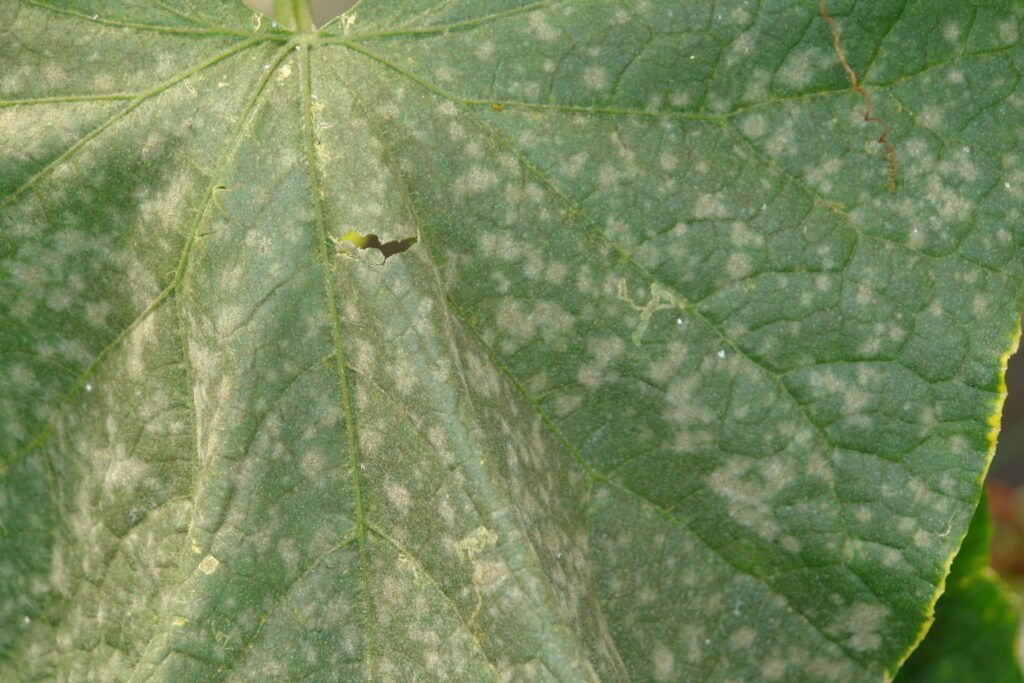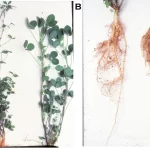
Written by: Becky Anderson
Published by: David Santos
As summer approaches and the temperatures rise, so do humidity levels. Southern Ontario is notorious for humid weather which can have lasting impacts on agricultural success. Humidity provides ideal conditions for fungi to grow, including mold and mildew. Greenhouses and indoor farms can be damp and humid environments. Without proper temperature control and ventilation, fungi can thrive. Additionally, due to the close proximity of plants, fungal diseases can spread quickly and cause severe damage.
Keeping these factors in mind, economic loss on hydroponic farms due to fungal diseases is huge. With up to 10-80% tomato loss due to Fusarium wilt caused by Fusarium oxysporum [1].
What are fungi?
We know that fungi can thrive in hydroponic farms, but what exactly are fungi? They are living organisms that produce spores and feed on organic matter, usually dead and decaying material. You may be familiar with some fungi including mushrooms, yeast, mildew, and mold. Lichen is a unique category, where fungi and bacteria such as cyanobacteria, form a symbiotic, mutualistic relationship. However, since lichen is not typically an issue in hydroponic systems, we will focus on fungi primarily found the be pathogenic or beneficial.
Kingdom: The second highest taxonomic rank, just below domain.
Spores: A reproductive cell that is capable of developing into a new individual without fusing with another cell.
Spores: A reproductive cell that is capable of developing into a new individual without fusing with another cell.
Organic matter: Source of carbon in an environment, typically originated from animal feces or dead plants and animals.
Cyanobacteria: A type of aquatic bacteria, also known as blue-green algae which obtain energy using photosynthesis.
Symbiotic: A close relationship between two individuals/organisms.
Mutualistic: A relationship between two individuals/organisms who work together and both benefit.
Growth
Fungi grow well in humid, warm environments, but it might surprise you that fungi can grow at temperatures ranging from below 0˚C to around 60˚C [2]. This temperature range is quite impressive and allows for fungi to disperse and persist in many natural environments.
Since hydroponic systems typically run between 18-26˚C (65-80˚F), the fungi which will be the most problematic are the mesophilic fungi and some fungi which are on the edge between psychrophilic and mesophilic, Figure 1.
Reproduction and transmission
Spores are very tiny particles that act as seeds for fungi. Spores are very difficult to kill and can go into a dormant stage when threatened or in an uninhabitable environment. This dormant stage is like hibernation for fungi when the environment is not optimal for growth. When dormant, cells are not dead, instead they stop using energy and halt growth and reproduction.
When the environment becomes favorable, the spores will leave their dormant state and continue to reproduce. Spores are very tiny and can travel on objects, including people, insects, or tools/equipment. They can also become airborne and carried by the wind to nearby plants. These factors make fungal diseases difficult to contain.
Fungi in hydroponic systems
Problematic fungi
Fungal diseases (Table 1) in crops can be detrimental, financially and mentally. Outbreaks in an indoor, closed environment, can spread faster due to the proximity of plants, but also poor air filtration and lack of humidity control can make the problem worse.
Table 1. Common fungal diseases in hydroponic plants and their causative agents.
| Causative Agent (Pathogen) | Fungal Disease | Plant Host Examples |
|---|---|---|
| Botrytis cinerea | Gray mold or Botrytis blight | Lettuce, strawberries |
| Fusarium oxysporum | Vascular wilt or Fusarium wilt | Tomato, cucurbits |
| Leveillula taurica | Powdery mildew | Tomato, peppers, onions, lettuce, cucurbits |
| Podosphaera xanthii | Powdery mildew | Tomato, peppers, onions, lettuce, cucurbits |
| Rhizoctonia solani | Damping off and bottom rot | Lettuce, soybean, alfalfa |
| Sclerotinia minor | Drop or Sclerotinia rot | Lettuce, peppers, cauliflower, basil, radishes, legumes |
If crops in your hydroponic system are experiencing fungal diseases, some of these tips might help:
- Contact your local seed provider for resistant cultivars
- Always practice good hygiene, such as proper hand washing, as spores can travel on people and objects and contaminate crops
- Reduce the risk of disease spreading by increasing the distance between each plant
- Reduce humidity and increase airflow by installing a high-quality air filter, air purification system and/or dehumidifier
- Increase the salt concentrations of aqueous solutions so that fungi can no longer grow.
- If necessary, dispose of/properly disinfect infected crops to reduce the risk of reinfection.
- Proactively monitor your hydroponic systems for pathogenic microorganisms
Beneficial fungi
Not all fungi are bad, in fact, they are pivotal in recycling nutrients and many are medically and nutritionally significant. In hydroponic systems, fungi can be used as “biocontrol” which attempts to prevent or reduce infection caused by a pathogen by introducing a non-pathogenic microorganism. Some beneficial fungi that can protect against pathogenic fungi include some Trichoderma species, Gliocladium catenulatum [3; 4] and non-pathogenic Fusarium oxysporum [5].
- Trichoderma virens can protect maize from foliar pathogens and cotton from Rhizoctonia solani, by inducing the production of terpenoids and peroxidases in rhizospheres [6].
- Gliocadium catenulatum produces agents that protect hydroponic cucumbers and tomatoes from Pythium and Fusarium infections [7; 8].
- Non-pathogenic Fusarium oxysporum has been tested as a biocontrol agent against pathogenic F. oxysporum, Curvularia lunata, Rhizoctonia solani and showed a reduction in mycelium growth and increase in crop weight [5].
Although these are promising biocontrol methods, more research is needed to better understand the methods of protection and to identify correct doses of administration to ensure only beneficial interactions are occurring.
Hydroponically grown mushrooms:
This may or may not surprise you, but mushrooms can be grown hydroponically (Figure 3). Although mushrooms do not produce roots, they produce mycelium which is like a network of branches that provide a means of uptaking nutrients but also a method of communication with its environment. Mushrooms grow using a substrate with water, instead of being suspended in an aqueous solution.
Don’t be a statistic, learn how to protect your crops from fungal disease. Healthy Hydroponics can detect and protect your crops against Botrytis cinerea, Fusarium oxysporum, Rhizoctonia solani, Leveillula taurica, Podosphaera xanthii and Sclerotinia minor infection (Table 1, Figure 2). Check out the list of more than 500 pathogens that we are able to detect here or contact us for more information about microbial surveillance of hydroponic systems.
Like what you are reading?
Subscribe below to get weekly email updates and monthly newsletters.
References:
- Singh, V. K., Singh, A. K., Kumar, A. (2017). Disease management of tomato through PGPB: current trends and future perspective. Biotech, 7(4), 255.
- Dix, N.J., Webster, J. (1995). Fungi of Extreme Environments. In Fungal Ecol.; Dix, N.J., Webster, J., Eds.; Springer: Dordrecht, The Netherlands; pp. 322–340
- Lee, S., Lee, J. (2015). Beneficial bacteria and fungi in hydroponic systems: types and characteristics of hydroponic food production methods. Sci. Hortic. 195, 206–215.
- Khalil, S., Alsanius, B.W. (2009). Utilisation of carbon sources by Pythium, Phytophthora and Fusarium species as determined by Biolog® microplate assay. Open Microbiol. J. 3, 9.
- Thongkamngam T., Jaenaksorn T. (2017): Fusarium oxysporum (F221-B) as biocontrol agent against plant pathogenic fungi in vitro and in hydroponics. Plant Protect. Sci., 53: 85-95.
- Howell, C.R., Hanson, L.E., Stipanovic, R.D., Puckhaber, L.S. (2000). Induction of terpenoid synthesis in cotton roots and control of Rhizoctonia solani by seed treatment with Trichoderma virens. Phytopathology 90, 248–252.
- Rose, S., Parker, M., Punja, Z.K. (2003). Efficacy of biological and chemical treatments for control of fusarium root and stem rot on greenhouse cucumber. Plant Dis. 87, 1462–1470.
- Khalil, S., Alsanius, B.W. (2010). Evaluation of biocontrol agents for managing root diseases on hydroponically grown tomato. J. Plant Dis. Protec. 117, 214–219.
Image sources:
Figure 1. https://ecampusontario.pressbooks.pub/microbio/chapter/temperature-and-microbial-growth/
Figure 2A https://hgic.clemson.edu/factsheet/gray-mold-botrytis-blight-2/
Figure 2B https://www.planetnatural.com/pest-problem-solver/plant-disease/fusarium-wilt/ Figure 2C https://www2.ipm.ucanr.edu/agriculture/lettuce/Rhizoctonia-diseases/
Figure 2D https://www2.ipm.ucanr.edu/agriculture/tomato/Powdery-Mildew-on-Field-Grown-Tomatoes/
Figure 2E https://content.ces.ncsu.edu/cucurbit-powdery-mildew
Figure 2F https://www2.ipm.ucanr.edu/agriculture/lettuce/lettuce-drop/
Figure 3 https://ruralleaders.co.nz/breen-cowie-operating-low-tech-small-scale-mushroom-farm/





